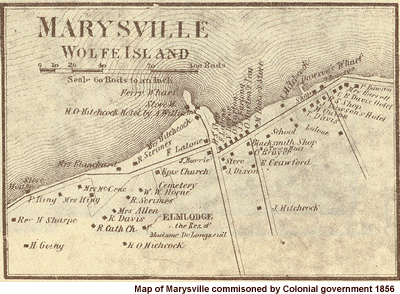History of Wolfe Island
Written by Mrs. James Hawkins, 1967
Wolfe Island, located directly opposite the City of Kingston, forms a natural boundary between Canadian and United States shores, at the entrance to the St. Lawrence River. The island is some twenty miles in length and ranges from one to seven miles in breadth; a fertile Island of over 30,000 acres in area. It is the largest of the famed “Thousand Islands”. It divides the St. Lawrence River and Lake Ontario and has the Canal Channel on the south. It might well be called the gateway to the Seaway.
The early Indian name of the island was “Ganounkouesnot” meaning “Long Island Standing up” thus we see that Indians themselves chose a name in keeping with the size of Wolfe Island, later it was called Long Island. During the French regime it was called Grand Island, then in 1792 by a proclamation issued by Govenor Simcoe while under British rule it was named Wolfe in honour of General James Wolfe.

In its primitive state the island was densely wooded and abounded with game, a real hunting ground for the Indian, but little permanent settlement can be traced of the early Indian except in the Button Bay vicinity which seems to have been a burial ground, and on the north shore at Brophy’s point where archaeologists have dug up many relics.
Samuel de Champlain in 1615 is presumed to have been the first white man of note to visit Wolfe Island, while returning from an expedition against the Iroquois. The route pursued brought the war party from the vicinity of Sacketts Harbor on the American Shore to Wolfe Island, thence across the channel to the mainland at Cataraqui.
Little mention can be found of the Island until 1675 when it was granted to Robert Cavelier, Sieur de La Salle, in connection with the seigneury of Frontenac by Louis XIV, King of France on the 13th day of May, 1675 which included, “The property called Frontenac and four leagues of adjacent country. Computing at 2000 toises each league, along the lakes and rivers above and below said fort, and half a league, or 1000 toises inland, the island named Ganounkouesnot (Wolfe Island) and Kaounesgo (Amherst Island) and the adjacent islets, with the right of hunting and fishing on said Lake Ontario and circumjacent rivers.”
La Salle was to pay back 10,000 livres, which the Fort had cost the King, to maintain a garrison, to build a church whenever the number of inhabitants reached 100, and to “domesticate” the Indians in the neighbourhood. No evidence exists that LaSalle made any effort to colonize or improve the island in any manner.
On 25 November 1685, during La Salle's absence from Fort Frontenac, his duly authorized attorney, La Foret confirmed a grant of the island with its appertenances to James Cauchois in 1681 upon the terms and conditions of the original grant. This instrument is considered to be the first conveyance of any part of what is now known as the province of Ontario, from one subject to another.
The new owner, Cauchois, died in 1708 (buried Aug 5) intestate leaving as his heiress his daughter Madeleine who was married to a Curot (sometimes seen as Cureaux), a store-keeper at Fort Frontenac, on 26 Aug 1713, some five years AFTER her father's death. At her death the island passed to her only son Jacques-François Curot, who entered the priesthood in March 1784, and conveyed all his rights and interests in the island to his half brothers, Amable and Michael Curot. About the beginning of the 19th century the Curot Bros. sold all their rights to the island to David Alexander Grant and Pat Langan, purchase price 1,500 pounds for 30,000 acres. This transfer terminated what might be considered direct French interest in the island.
Any settlement attempted by early French owners was apparently in the vicinity of the present village of Marysville, opposite Fort Frontenac and along the front road. This is the only section that permitted settlers to live together along the roadway in front of their holdings.
During the Revolutionary War, 1776-1783, a British patrol from Carleton Island kept watch on the Island and Loyalist refugees passed across it to and from the outpost maintained at Cataraqui. Some stayed on Wolfe Island and started to clear the land, thus most of our first settlers were United Empire Loyalists.
David Alexander Grant in 1781 married Marie Charles Josephe le Moyne de Longueuil, a Baroness, only daughter of the 3rd Baron de Longueuil. At his death in March 1806 his eldest son, the Honourable Charles William Grant, his heir became the 5th Baron of Longueuil. Charles Grant's wife, Caroline, until her death in 1868, owned a considerable part of the Island.
Pat Langan, who shared in purchase died leaving three daughters, Julia, Marie and Charlotte. Julia married the honourable James Leslie, for years members of the Legislature of Lower Canada. Maria became the wife of Archibald Kennedy Johnson. These marriages account for the interests of the Leslie’s and Johnson’s in the Island property. The Honorable Charles Wm. Grant’s only daughter, who was married to the Rev. J. A. Allen, one-time clergyman on Wolfe Island, acquired his holdings therefore, most of the properties were at one time controlled by Leslies, Johnson or Allen.
In the first decades of the 19th century about 15 families constituted its european population. These were all located on the Grant and Langan seigneury which after the change in 1823 could be bought from 5-6 dollars per acres, or leased for 1 shilling per acre per annum for long terms as long as 99 years. Among the names of early settlers from that time are noted those of Bennett, Davis, Mozier or Mosier, Hitchcock, Martin, Spoor, Wilson, Hinchley, and Staley some being of United Empire Loyalist descent and most having still descendents on the Island.
Settling increased after the war of 1812, members of the MacDonald Clan from the County of Glengarry formed what became known as the Scottish Settlement. Daniel Cook settled on the south side of the island about 1837 and this section is known as the ridge.
History of Wolfe Island, written by Mrs. Ruth Hawkins appears with the kind permission of the families of Mrs. Nadine Greenwood, Mr. Joseph Hawkins as well as The Wolfe Island Centennial Committee (Chairman Mable McRae, Co-Chairman Reverend Harold Murray, and Secretary-Treasurer Everett Hogan.) that was formed to celebrate Old Home Week during August 11-19, 1967.
Follow this link for information onBarbara Larocque's Island history project





